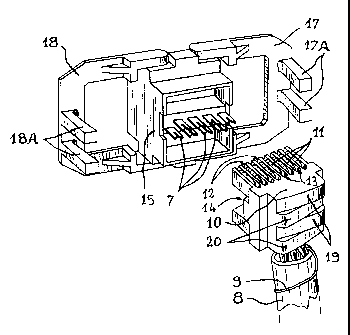Some of the information on this Web page has been provided by external sources. The Government of Canada is not responsible for the accuracy, reliability or currency of the information supplied by external sources. Users wishing to rely upon this information should consult directly with the source of the information. Content provided by external sources is not subject to official languages, privacy and accessibility requirements.
Any discrepancies in the text and image of the Claims and Abstract are due to differing posting times. Text of the Claims and Abstract are posted:
| (12) Patent: | (11) CA 2228900 |
|---|---|
| (54) English Title: | MURAL FEMALE SOCKET OF THE MODULAR-JACK TYPE |
| (54) French Title: | PRISE MURALE DE TYPE MODULAIRE |
| Status: | Expired and beyond the Period of Reversal |
| (51) International Patent Classification (IPC): |
|
|---|---|
| (72) Inventors : |
|
| (73) Owners : |
|
| (71) Applicants : |
|
| (74) Agent: | MACRAE & CO. |
| (74) Associate agent: | |
| (45) Issued: | 2005-06-28 |
| (22) Filed Date: | 1998-02-05 |
| (41) Open to Public Inspection: | 1998-08-27 |
| Examination requested: | 2002-09-11 |
| Availability of licence: | N/A |
| Dedicated to the Public: | N/A |
| (25) Language of filing: | English |
| Patent Cooperation Treaty (PCT): | No |
|---|
| (30) Application Priority Data: | ||||||
|---|---|---|---|---|---|---|
|
This invention relates to a mural socket of the "Modular-Jack"
type, provided to receive cables arriving from very varied directions. It is
associated with a termination pusher which is totally symmetrical with
respect to its transverse plane. Jaws fixed on the socket cooperate with
shapes on the rear of the pusher in order to grip it and introduce it by
force, with lever effect, in its receiving part, itself provided with
I.D.C.'s.
Note: Claims are shown in the official language in which they were submitted.
Note: Descriptions are shown in the official language in which they were submitted.

2024-08-01:As part of the Next Generation Patents (NGP) transition, the Canadian Patents Database (CPD) now contains a more detailed Event History, which replicates the Event Log of our new back-office solution.
Please note that "Inactive:" events refers to events no longer in use in our new back-office solution.
For a clearer understanding of the status of the application/patent presented on this page, the site Disclaimer , as well as the definitions for Patent , Event History , Maintenance Fee and Payment History should be consulted.
| Description | Date |
|---|---|
| Inactive: IPC expired | 2018-01-01 |
| Inactive: IPC deactivated | 2011-07-29 |
| Inactive: IPC deactivated | 2011-07-29 |
| Time Limit for Reversal Expired | 2008-02-05 |
| Letter Sent | 2007-02-05 |
| Inactive: IPC from MCD | 2006-03-12 |
| Inactive: IPC from MCD | 2006-03-12 |
| Inactive: IPC from MCD | 2006-03-12 |
| Inactive: IPC from MCD | 2006-03-12 |
| Inactive: IPC from MCD | 2006-03-12 |
| Inactive: IPC from MCD | 2006-03-12 |
| Grant by Issuance | 2005-06-28 |
| Inactive: Cover page published | 2005-06-27 |
| Pre-grant | 2005-04-11 |
| Inactive: Final fee received | 2005-04-11 |
| Notice of Allowance is Issued | 2004-12-30 |
| Notice of Allowance is Issued | 2004-12-30 |
| Letter Sent | 2004-12-30 |
| Inactive: Approved for allowance (AFA) | 2004-12-13 |
| Amendment Received - Voluntary Amendment | 2004-12-02 |
| Inactive: S.30(2) Rules - Examiner requisition | 2004-08-18 |
| Amendment Received - Voluntary Amendment | 2002-11-26 |
| Letter Sent | 2002-11-01 |
| Request for Examination Received | 2002-09-11 |
| Request for Examination Requirements Determined Compliant | 2002-09-11 |
| All Requirements for Examination Determined Compliant | 2002-09-11 |
| Application Published (Open to Public Inspection) | 1998-08-27 |
| Inactive: First IPC assigned | 1998-05-13 |
| Classification Modified | 1998-05-13 |
| Inactive: IPC assigned | 1998-05-13 |
| Inactive: IPC assigned | 1998-05-13 |
| Inactive: IPC assigned | 1998-05-13 |
| Filing Requirements Determined Compliant | 1998-04-29 |
| Inactive: Filing certificate - No RFE (English) | 1998-04-29 |
| Application Received - Regular National | 1998-04-28 |
There is no abandonment history.
The last payment was received on 2005-01-20
Note : If the full payment has not been received on or before the date indicated, a further fee may be required which may be one of the following
Please refer to the CIPO Patent Fees web page to see all current fee amounts.
| Fee Type | Anniversary Year | Due Date | Paid Date |
|---|---|---|---|
| Application fee - standard | 1998-02-05 | ||
| Registration of a document | 1998-02-05 | ||
| MF (application, 2nd anniv.) - standard | 02 | 2000-02-07 | 2000-01-10 |
| MF (application, 3rd anniv.) - standard | 03 | 2001-02-05 | 2001-01-29 |
| MF (application, 4th anniv.) - standard | 04 | 2002-02-05 | 2002-01-11 |
| Request for examination - standard | 2002-09-11 | ||
| MF (application, 5th anniv.) - standard | 05 | 2003-02-05 | 2003-01-29 |
| MF (application, 6th anniv.) - standard | 06 | 2004-02-05 | 2004-01-22 |
| MF (application, 7th anniv.) - standard | 07 | 2005-02-07 | 2005-01-20 |
| Final fee - standard | 2005-04-11 | ||
| MF (patent, 8th anniv.) - standard | 2006-02-06 | 2006-01-19 |
Note: Records showing the ownership history in alphabetical order.
| Current Owners on Record |
|---|
| POUYET S.A. |
| Past Owners on Record |
|---|
| YVES BOUDIN |